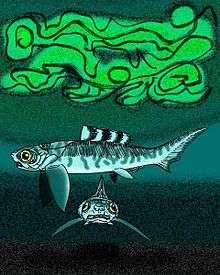Pachyosteus
| Pachyosteus Temporal range: Late Frasnian to Famennian[1] | |
|---|---|
 | |
| Fossil on display | |
 | |
| Artist's reconstruction | |
| Scientific classification | |
| Kingdom: | Animalia |
| Phylum: | Chordata |
| Subphylum: | Vertebrata |
| Class: | Placodermi |
| Order: | Arthrodira |
| Suborder: | Brachythoraci |
| Infraorder: | Coccosteina |
| Superfamily: | Dinichthyloidea |
| Family: | Selenosteidae |
| Genus: | Pachyosteus |
| Species: | P. bulla |
| Binomial name | |
| Pachyosteus bulla Jaekel 1903 | |
| Synonyms | |
| |
Pachyosteus bulla is a medium-sized selenosteid arthrodire placoderm known from the Upper Frasnian Kellwasserkalk facies of Late Devonian Bad Wildungen, Germany and from the Famennian portions of the Holy Cross Mountains of Poland. P. bulla has a broad skull about 7 to 10 centimeters long, a comparatively long median dorsal plate, and a short rostral plate that meets the pineal plate. In his cladogram, Rücklin (2011) regards P. bulla as a basal selenosteid, being the sister taxon of the American genera, and the Kellwasserkalk genera of Germany and Morocco.[2]
References
- ↑ Denison, Robert (1978). Handbook of Paleoichthyology, Volume 2, Placodermi. New York: Gustav Fischer Verlage. p. 94. ISBN 9780895740274.
- ↑ RÜCKLIN, MARTIN (January 14, 2011). "First selenosteid placoderms from the eastern Anti-Atlas of Morocco; osteology, phylogeny and palaeogeographical implications". Paleontology. 56 (1): 25–62. doi:10.1111/j.1475-4983.2010.01026.x.
This article is issued from Wikipedia - version of the 5/24/2015. The text is available under the Creative Commons Attribution/Share Alike but additional terms may apply for the media files.